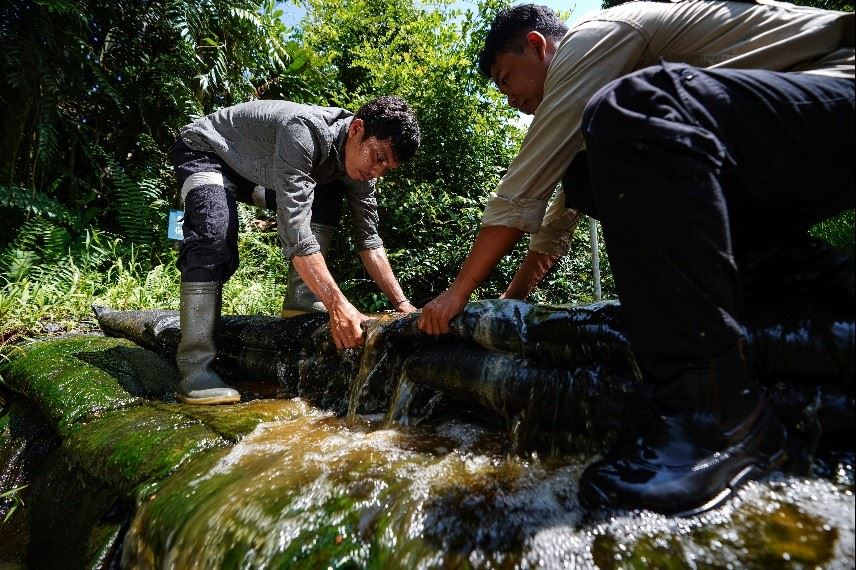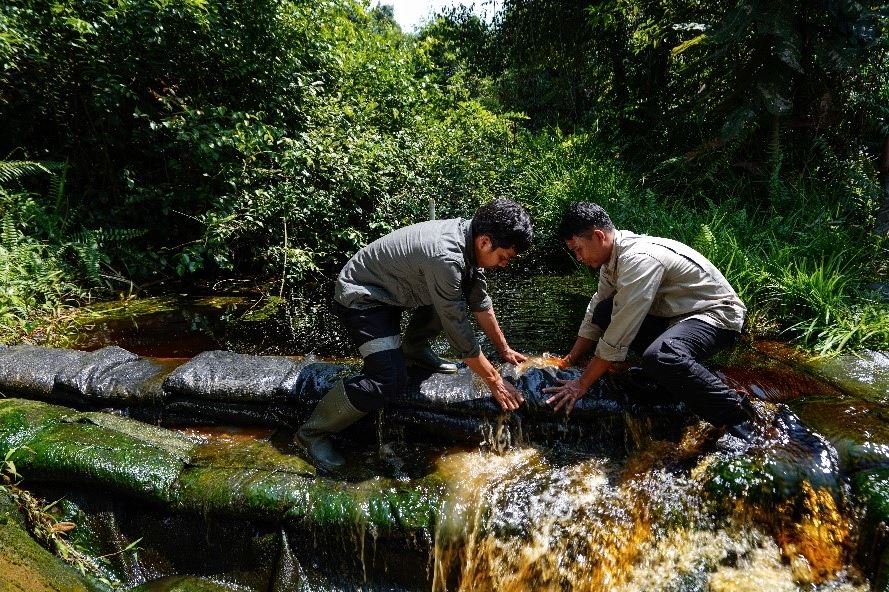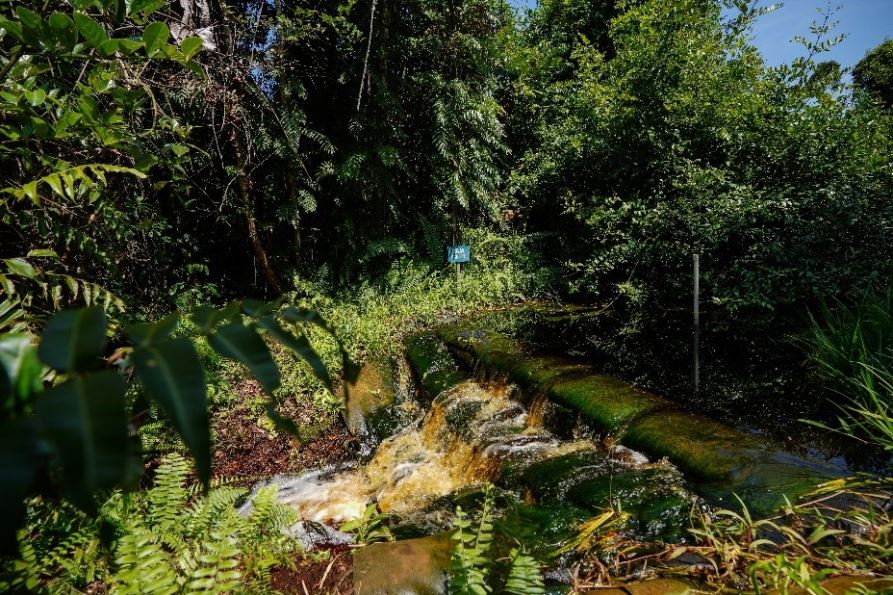October 31, 2023
Did you know that a healthy peatland forest is about 90 percent water? These habitats are thirsty places, relying on water table dynamics to create new peat, store carbon, and recycle nutrients. In fact, water is the lifeblood of peatland areas. Therefore, keeping these wild places wet is essential to their survival.
In the past, when loggers moved into peatland areas, they built canals to access the forest and transport timbers. Aside from the obvious destruction of habitat these operations caused, there was another, unexpected impact on the environment: Canals drained water out of the soil, leaving peatlands parched and struggling to function.

When peatlands dry out, they are at increased risk of fire. And that can result in huge amounts of carbon being released into the atmosphere. To prevent this from happening, Restorasi Ekosistem Riau (RER) is working to rehydrate peat forests and return them to their natural state. By blocking up drainage canals, we’re restoring the water table and helping rehydrate the land. This approach is proven to be an effective way of preventing fires in peatland forests.
But how does it work? In this article, we’ll explore the importance of fire prevention to peatland forests, take a closer look at canal blocking operations in RER, and delve into the many environmental benefits they offer.
Dangers of the dry season in Indonesia
Located right on the equator in the tropical hot house of our planet, Indonesia has just two seasons: the dry, which normally stretches from April to October; and the wet, which is from November to March.
In the wet season, water can be seen several centimeters above ground level in peatland swamps. During the dry season, when some places go without rain for weeks or even months at a time, the water level can drop to around 100 cm below the surface. For swamps and peatland forests, this drought spells danger.
Dry peat enhances peat oxidation and decomposition, releasing carbon dioxide into the atmosphere and increasing the risk of fire.
In RER, recent years have been especially dry. In February 2021 Padang Island saw just 103.9 mm of rain, while the Kampar Peninsula was even drier in July, with only 94.1 mm. Dry peat enhances peat oxidation and decomposition, releasing carbon dioxide into the atmosphere.
During these arid periods, the water table can drop to dangerously low levels, leaving the land as dry as kindling. This makes fire prevention and protection an essential part of ecosystem restoration.
How canal blocking helps prevent fires
Most of the existing drainage canals in RER are around 3-30 feet (1-9 meters) wide and 20-60 inches (50-150 cm) deep. These canals suck water from the forest, drying out swamps and contributing to peat subsidence. Blocking them up with dams helps return life-giving water to the land and keep it safe from fire. This makes canal blocking one of the most effective fire prevention measures for peatland swamps.
But how does the process of canal blocking actually work? First, a team of RER water management specialists and fire prevention engineers identify where the canals are located, then conduct a profile-leveling survey. This helps identify the perfect spot to build our dams.
Next, we block up the mouth of these canals with sandbags, each weighing around 55-66 lbs. (25-30 kg). It takes around 80-300 bags to build a single dam, placed in a step formation so the structure is strong enough to block the flow of water.

Once the dam is in place, water spills over into peatland, stopping the soil from drying out, preventing oxidation, and reducing subsidence. Canal blocking is having a major impact on fire prevention, especially during the dry season. In recent years, there have been plenty of positive impacts to report from RER.
The impact of canal blocking in RER
Since 2016, the RER team has been working to close old drainage canals, keeping peatlands healthy and hydrated in Riau. This in turn has helped to minimize the risk of fire; preventing harmful emissions by keeping carbon in the ground, where it belongs. Thanks to this and other measures, there were no fire incidents in or around the RER area on the Kampar Peninsula in 2021.
In 2021, our team identified 39 canal systems, stretching more than 125 miles (202 km) across the RER area. Twenty-five of these can be found on the Kampar Peninsula, covering 85 miles (137 km) and impacting 8,678 hectares of land. The other 14 canals are on Padang Island, covering a combined length of 40 miles (65 km) and impacting 3,966 hectares of peatland.
In the past five years, RER has built 87 dams and blocked a total of 31 canal systems, inundating 12,644 hectares of peatland in Riau
That same year, we built eight dams that closed four canal systems and helped provide water to 9,359 hectares of peatland. In total, over the past five years, we’ve successfully built 87 dams and blocked a total of 31 canal systems, stretching 109 miles (176.5 km) and inundating 12,644 hectares of peatland on the Kampar Peninsula and Padang Island.
Restoration, fire prevention and safety: Looking to the future
RER is working to raise water levels in 40-cm steps along the length of each canal – a bit like rice terraces in Bali – that will slow the flow of water. Once the dams are completed, the waterways will spill over into the surrounding landscape, helping keep it nice and soggy – even during the dry season.

Our mission is to block up the entire RER canal network in this way by 2025. So far, we’ve achieved 74 percent of our overall target for the region. We also plan to leave two control canals open, so we can research the effects of canal blocking on the water table and assess the overall condition of the landscape. This research project will be completed in 2025.
By returning life-giving water to the land, RER is helping restore peatlands to their natural state, while also significantly reducing the risk of fires to surrounding areas. In addition to these practical benefits, canal blocking is also symbolic; by dismantling the last relics of a more destructive era, we’re signaling our intent and, quite literally, shaping the future of landscapes in Riau.